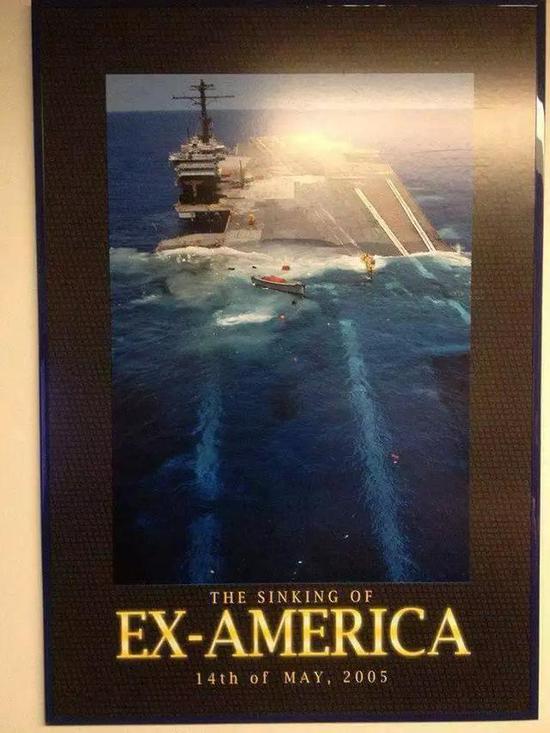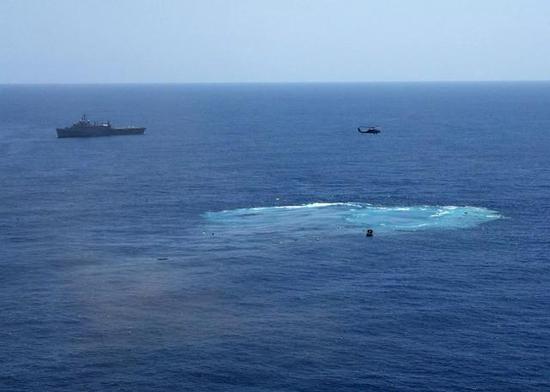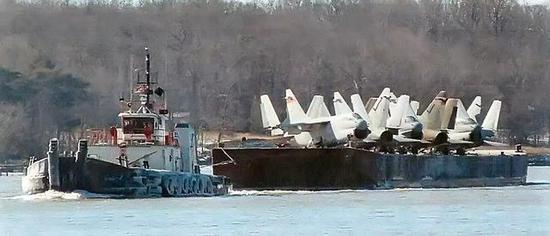PAY MORE TAX!
http://www.thedrive.com/the-war-zon...5-years-and-over-1-5b-to-scrap-uss-enterprise
 The Navy Could Need More Than 15 Years and Over $1.5B To Scrap USS Enterprise
The Navy Could Need More Than 15 Years and Over $1.5B To Scrap USS Enterprise
No one has ever done this before and the service is struggling to figure out how best to get rid of its first nuclear-powered supercarrier.
By Joseph TrevithickAugust 2, 2018
 John Whalen/Huntington Ingalls Industries
John Whalen/Huntington Ingalls Industries
SHARE
A new report from the Government Accountability Office, or GAO, says that it could cost the Navy more than $1.5 billion to fully dispose of the retired ex-USS Enterprise, a complete process that could take more than 15 years to finish. The watchdog says the service should get at least one independent review of those projected costs and begin keeping studious records, not only to make sure it’s getting the best deal, but to also learn as much as possible from this unprecedented ship breaking effort for when it retires its Nimitz class supercarriers.
The Navy officially decommissioned Enterprise, also known by its hull number CVN-65, in February 2017, after more than five decades of service. The ship had already effectively been in mothballs since 2012 and Newport News Shipbuilding completed a lengthy “inactivation” process, which included removing nuclear fuel, mission systems, and other items from the ship, in April 2018.
This Video About The Navy's Decaying Shipyards Makes Its 355 Ship Goal Seem LaughableBy Tyler Rogoway Posted in The War Zone
CVN-81, The Fourth Ford Class Supercarrier, Is Slated To Cost A Whopping $15BBy Tyler Rogoway Posted in The War Zone
Navy Could Extend The Life Of USS Nimitz Past 50 Years To Maintain 12 Carrier FleetBy Tyler Rogoway Posted in The War Zone
Shock Trials or No, the Navy's Newest Supercarrier Is Still an Unreliable DebacleBy Joseph Trevithick Posted in The War Zone
Emergency Declared After Tunnel Full Of Nuclear Waste Collapses At Hanford (Updated)By Tyler Rogoway Posted in The War Zone
“At approximately 76,000 tons, CVN-65 will require an unprecedented level of work to dismantle and dispose of as compared to previous ships,” GAO’s review, which the congressional office published publicly on Aug. 2, 2018, said. “Regardless of the approach the Navy chooses, CVN-65 will set precedents for the processes, costs, and oversight that may be used to dismantle and dispose of nuclear-powered aircraft carriers in the future, such as the Nimitz-class carriers which the Navy will begin to retire in the mid-2020s.”
The only ship of her class, Enterprise was also the first ever nuclear-powered aircraft carrier to enter service anywhere in the world. The Navy expects to send the USS Nimitz, the first ship in the class that came after CVN 65, into retirement in 2023, after sometime after the future Ford-class flattop USS John F. Kennedy enters service. There is already considerable debate over this plan, though, and Congress may block the retirement in order to maintain a 12-carrier fleet.
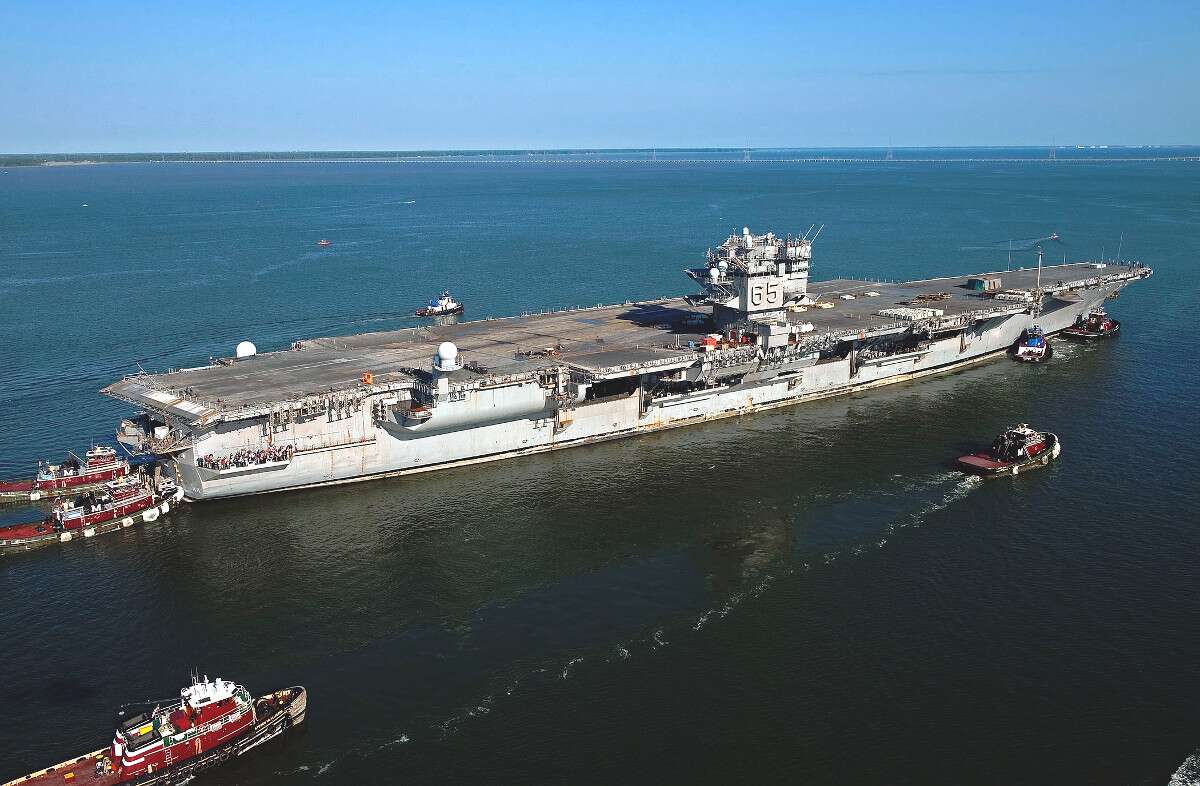
USN
Tugs move the USS Enterprise into Newport News Shipbuilding's yards in 2013.
How to dispose of the “Big E,” as she was nicknamed, has already been a complicated and arduous affair. The Navy originally projected that it would cost somewhere between $500 and $750 million to scrap it, but by 2013, this figure had grown to over $1 billion. The difficulties have forced the service to push back the start of the process more than once already and the ship’s hulk is presently sitting in Hampton Roads, Virginia.
The Navy is now considering two potential options, according to GAO. The first of these is doing the work at a naval shipyard with the help of contractors, while the second would see the service turn the ship over to a private company to break down at their own facility.
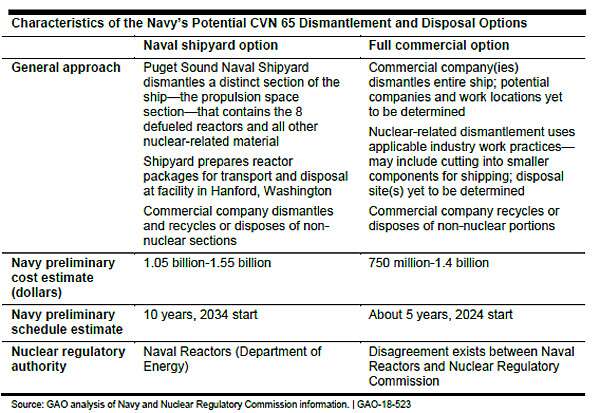
GAO
A basic breakdown of the Navy's two options for what to do with the ex-Enterprise.
Historically, the Navy has done this work at the Puget Sound Naval Shipyard and Intermediate Maintenance Facility in Bremerton, Washington. When it comes to breaking down nuclear-powered vessels, this facility has the added benefit of being relatively close to the Department of Energy’s Hanford low-level radioactive waste disposal site, which is also in Washington State. This is where the Navy would send the eight de-fueled nuclear reactors and related components from the ex-Enterprise.
GAO acknowledged in its review that the Navy had a better sense of the costs and time required to proceed with this plan based on its existing experience. Unfortunately, there are serious concerns that using one of the service’s own overworked shipyards to scrap the supercarrier would only add to an increasingly troubling maintenance backlog for active ships and submarines.

GAO
An infographic showing how the Navy typically moves decommissioned nuclear reactors from the Puget Sound Naval Shipyard to Hanford.
In September 2017, the watchdog released a separate review highlighting the poor and decaying state of the Navy’s shipyards. The next month is published yet another report specifically on delays in maintenance availabilities for Los Angeles- and Virginia-class attack submarines. At the time of writing, the Los Angeles-class boat USS Boise is still just sitting idle pier side after more than 30 months of inactivity.
The Navy only expects the repairs on Boise to begin in 2019. On Aug. 2, 2018, the service put out a request for information to try and identify commercial shipyards that it could certify for government work or ones that already have that certification, but are not working at full capacity, in order to try and make up for some of these shortfalls.
The fear is these shipyard capacity issues could also lead to greater costs if the process drags out. The Navy says the Puget Sound option could cost anywhere from $1.05 to $1.55 billion, take 10 years to complete, and wouldn’t even start until 2034.
The other option, then, is to have a contractor, such as Newport News, do the job at one of their facilities. This could shorten the time it takes to break down the former Enterprise to only five years and get the work going in 2024.
The issue here is that no government or private shipyard has ever done anything like this on this scale. It could quickly become expensive as contractors begin ripping things apart and find out that their expectations don’t line up with what they’ve discovered waiting for them – something that’s happened before with much smaller, less complicated systems, such as fighter jets.
The unique nature of Enterprise's design could make things even more complex. More than two decades after the Navy struck it from the rolls, the bulk of the hull, including the reactor compartments, of the ex-USS Long Beach, another one-off design and the first-ever nuclear-powered cruiser in the world, is still sitting in long-term storage at the Washington State base.
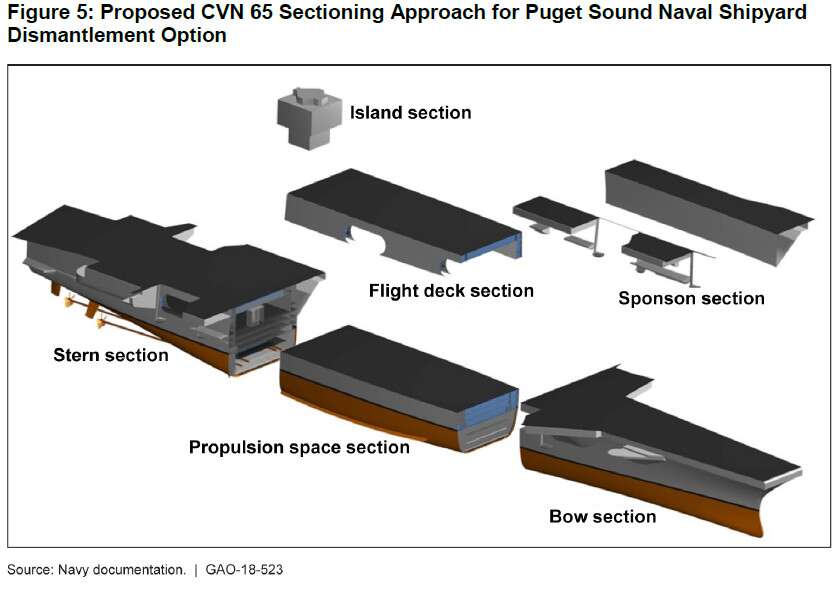
GAO
A graphic showing how the Navy would plan to break down the ex-Enterprise if it did the work at Puget Sound.
And though the Navy has moved reactors and other irradiated materials from Puget Sound to Hanford in the past, the sheer volume of materials associated with eight individual reactor plants will make this effort more akin to decommissioning a nuclear power plant. For a commercial contractor, getting legal and regulatory approval to dismantle the reactors, in particular, could be complicated and limit the available sites where the work could occur.
The Navy and the independent Nuclear Regulatory Commission (NRC) already disagree on what standards should apply to the commercial option. The Navy says that if a commercial company does the work, NRC’s should view it through the lens of commercial nuclear regulations. The NRC says that dismantling a naval nuclear reactor is akin to disposing of a nuclear weapon from a regulatory standpoint and that the Navy needs to be responsible for the process and disposing of the waste at a site such as Hanford.
Furthermore, NRC only has direct authority over such matters in thirteen states, not including Virginia, where the ex-Enterprise is now. State authorities have entered into agreements with the commission in all other instances to take responsibility for nuclear waste and other related matters and might not be willing to take on the task of overseeing the disposal of eight military-grade reactors. And not mentioned at all is the highly classified nature of U.S. naval nuclear reactor design, the details of which any company would have to guard very closely throughout the process regardless.
So, while there might be an understanding of the general approach a commercial company would take to break up the ex-Enterprise, there’s no real understanding of what the process might entail, especially with regards to the nuclear components. For example, GAO said in its report that the Navy, for unknown reasons, estimated that it would cost less to dispose of each of the ship’s nuclear reactors than it typically does to get rid of commercial reactors of a similar size. With so many unknowns, the estimated final cost for the commercial option is a wide range that sits anywhere from $750 million to $1.4 billion.
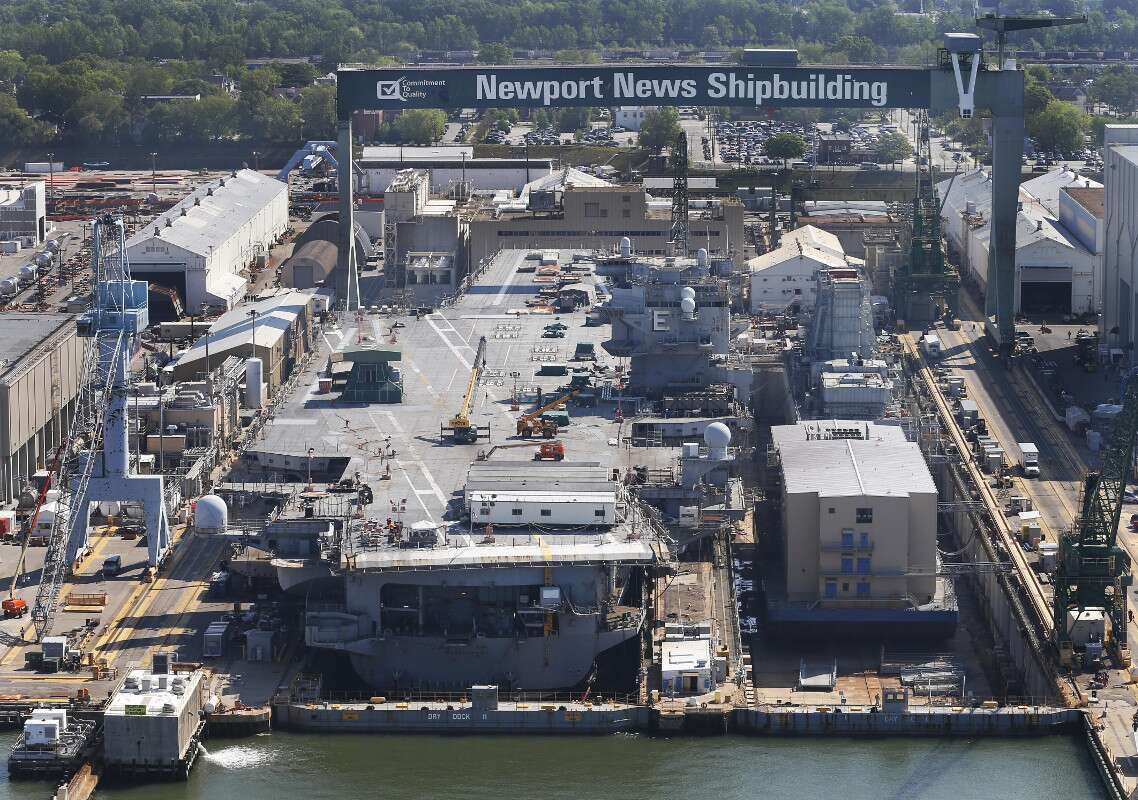
Steve Helber/AP
The USS Enterprise in dry dock at Newport News' yard in 2016 during the inactivation process.
“As the Navy considers how to proceed, it will be critical to ensure that there is sufficient oversight and accountability for what likely will be an effort greater than $1 billion that lasts the better part of a decade,” GAO’s reviews wrote in their conclusion. “Without establishing a cost and schedule baseline that has been validated by an independent cost estimate or assessment, it will be difficult for decision makers to track cost and schedule performance or have confidence in CVN 65 costs.”
As such, the watchdog recommended that the Navy have the Pentagon’s Office of Cost Analysis and Program Evaluation or the Naval Center for Cost Analysis draw up independent cost analyses of the two potential courses of action. They also said the service should keep and supply details accounting of the projected costs and the money it spends on the project, which it is not presently required to do for disposal programs.
In addition, GAO said that the Secretary of Defense needs to demand that the Navy craft a risk management plan no matter what course of action it takes and goes through a formal process to establish a baseline cost and schedule for the entire effort. Without this it would be difficult, if not impossible, to truly evaluate how things go, which could hamper the service’s ability to avoid the same mistakes in the future. The Department of Defense told the congressional office that it agreed with all of these suggestions.
It's also worth noting that how the disposal of Enterprise shakes out could have an impact on how the U.S. government views the costs associated with nuclear-powered aircraft carriers and could impact the growing debate about whether it makes sense to invest in smaller, conventionally-powered types. Since taxpayers will be responsible for the bill, a more accurate estimated lifecycle cost of a nuclear supercarrier should include this $1 billion or more to dispose of it at the end of the day.
As it stands now, the Navy hopes to have arrived at a final decision on what to do with the remnants of the Enterprise by 2023. We might not have to wait long to start seeing hints of which course of action the service truly prefers.
Contact the author: [email protected]
Don't forget to sign up
Your Email Address
https://www.popularmechanics.com/mi...-dismantling-uss-enterprise-nuclear-disposal/
The U.S. Navy Is Having a Hell of a Time Dismantling the USS Enterprise
Nobody has ever disposed of a nuclear-powered aircraft carrier before. Turns out it's not easy.

By Kyle Mizokami
Aug 10, 2018
5.2k
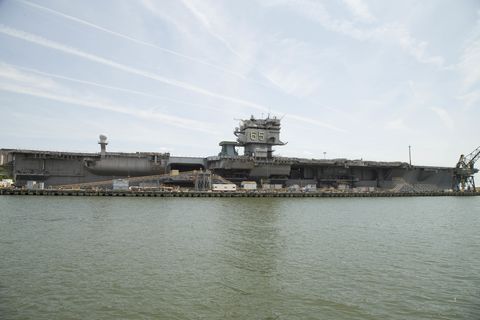
U.S. Navy photo by Mass Communication Specialist 2nd Class Cat Campbell
Six years after decommissioning USS Enterprise, the world's first nuclear-powered aircraft carrier, the U.S. Navy is still figuring out how to safely dismantle the ship. The General Accounting Office estimates the cost of taking apart the vessel and sending the reactors to a nuclear waste storage facility at up to $1.5 billion, or about one-eighth the cost of a brand-new aircraft carrier.
The USS Enterprise was commissioned in 1961 to be the centerpiece of a nuclear-powered carrier task force, Task Force One, that could sail around the world without refueling. The fleet was a symbol of the Navy’s global reach and its nuclear future. During its 51 years in operation, the Enterprise served in the Cuban Missile Crisis blockade, the Vietnam War, and the wars in Afghanistan and Iraq.
The Navy decommissioned Enterprise in 2012 (don’t worry, the third carrier of the new Gerald R. Ford class will be named Enterprise, so the name will live on) and removed the fuel from the eight Westinghouse A2W nuclear reactors in 2013. The plan was to scrap the ship and remove the reactors, transporting them by barge from Puget Sound Naval Base down the Washington Coast and up the Columbia River, then trucking them to the Department of Energy’s Hanford Site for permanent storage.
However, after decommissioning the cost of disposing of the 93,000-ton ship soared from an estimated $500-$750 million to more than a billion dollars. This caused the Navy to put a pause on disposal while it sought out cheaper options. Today the stripped-down hull of the Enterprise sits in Newport News, Virginia awaiting its fate.
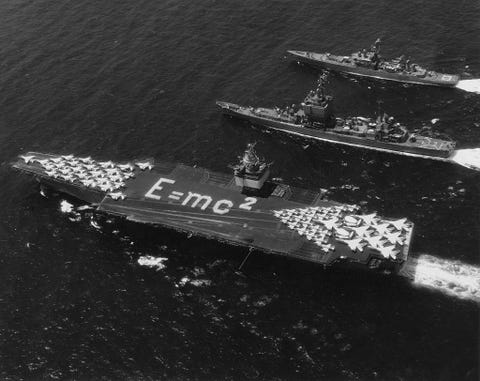
USS Enteprise as part of Task Force One, 1964.
Getty Images
Now, according to a new General Accounting Office report (PDF), the Navy has two options. The first is to have the Navy manage the job but let the commercial industry do the non-nuclear work. The Navy would allow industry to scrap the non-nuclear parts of the ship but preserve a 27,000-ton propulsion space containing the reactors. The propulsion space would then be transported to Puget Sound Naval Base, where the reactors would be removed and sent to Hanford. This is the most expensive option, costing a minimum of $1.05 billion up to $1.55 billion and taking 10 years to complete, starting in 2034.
The second option: let commercial industry do everything, with a reactor storage location to be determined. This would cost $750 million to $1.4 billion and would take 5 years to complete, starting in 2024. In either event, most of the ship gets turned into razor blades and flatware. (By comparison, a squadron of 10 F-35C Joint Strike Fighters costs $1.22 billion, and a brand new Burke-class guided missile destroyer costs $1.7 billion.)
The GAO report paints the commercial option as faster and cheaper, though there are a number of unknowns. Nobody knows where the hull will be dismantled under the commercial plan, nor where the reactors would be sent. Although the Navy believes disposing of the reactors will be fairly straightforward, no one has dismantled a nuclear-powered carrier before.
Compounding the issue is a “not my problem” intergovernmental dispute. The Naval Nuclear Propulsion Program, the arm of the Navy concerned with nuclear power, says the federal Nuclear Regulatory Commission could oversee a commercial effort. But the NRC says Navy nuclear reactors are not its job. It’s not clear exactly why NNPP doesn’t want the job, although it currently has a backlog of 10 submarine reactors and two cruiser reactor to deal with (which is probably why a Navy effort won’t start until 2034). Ultimately, according to the GAO, it may take Congress to make a decision.
Whatever the Navy ends up doing, this will only be the first of many nuclear-powered carrier disposals. USS Nimitz is set to retire within the next ten years, and there are ten ships in the class. These will age out every four or five years for the next forty years, and each has two reactors. The Navy must get Enterprise’s teardown right, because the orders are going to start stacking up.
Via The Daily Press
https://tech.slashdot.org/story/18/...tle-americas-nuclear-powered-aircraft-carrier
It'll Cost $1 Billion To Dismantle America's Nuclear-Powered Aircraft Carrier (popularmechanics.com) 193
Posted by EditorDavid on Saturday August 11, 2018 @03:34PM from the owning-a-boat dept.
"Six years after decommissioning USS Enterprise, the world's first nuclear-powered aircraft carrier, the U.S. Navy is still figuring out how to safely dismantle the ship," reports Popular Mechanics. schwit1 tipped us off to their report: The General Accounting Office estimates the cost of taking apart the vessel and sending the reactors to a nuclear waste storage facility at up to $1.5 billion, or about one-eighth the cost of a brand-new aircraft carrier.
The USS Enterprise was commissioned in 1961 to be the centerpiece of a nuclear-powered carrier task force, Task Force One, that could sail around the world without refueling.... The Navy decommissioned Enterprise in 2012 and removed the fuel from the eight Westinghouse A2W nuclear reactors in 2013. The plan was to scrap the ship and remove the reactors, transporting them by barge from Puget Sound Naval Base down the Washington Coast and up the Columbia River, then trucking them to the Department of Energy's Hanford Site for permanent storage. However, after decommissioning the cost of disposing of the 93,000-ton ship soared from an estimated $500-$750 million to more than a billion dollars. This caused the Navy to put a pause on disposal while it sought out cheaper options. Today the stripped-down hull of the Enterprise sits in Newport News, Virginia awaiting its fate.
"Although the Navy believes disposing of the reactors will be fairly straightforward, no one has dismantled a nuclear-powered carrier before...
"Whatever the Navy ends up doing, this will only be the first of many nuclear-powered carrier disposals."
http://mil.news.sina.com.cn/jssd/2018-08-13/doc-ihhqtawy1356316.shtml
美军拆解一艘退役核航母 要每个中国人掏一美元才够
美军拆解一艘退役核航母 要每个中国人掏一美元才够
0
美国海军功勋航母企业号正在拆解,据美国海军给出的报告,拆解费用将高达15亿美元。而美国政府所属的问责局对此表示,高达15亿的拆解方案存在许多疑点,将会对此展开调查。
我们虽然不知道这件事里面存在什么故事,但核动力航母的拆解,并不是一件容易的事。
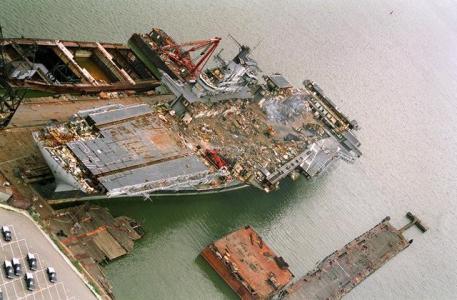 当年珊瑚海号拆了5年,还是常规动力航母
当年珊瑚海号拆了5年,还是常规动力航母
一般情况下,一般的船只拆解也不便宜,原因在于,船只拆解并不仅仅是将船拆了这么简单。即使是一般的民用船只,在拆解前都需要先将船体内的一切液体(燃料、润滑油、制冷液等等)抽出来,之后再将船体内的线路悉数去除,之后才能进行进一步的整体结构分解。
而到了军舰上,特别是核动力航母这样的大型主力战舰,其拆解难度将相当之高。由于特殊部件相当之多,在拆解前,需要人工将许多东西手动拆出航母,如火控系统、消防系统、弹射器等等。而且由于作战的需求,一些作战设备里往往含有一些有毒物质,需要专门的化学工作人员才能将它们移除。
更为重要的是,这是一艘核动力航空母舰,其核心部分便是核动力装备。现在的核动力航母都考虑到了进行核燃料更换,在设计之初便对核反应堆进行了模块化设计,使得更换核燃料变得方便。但作为美国第一艘核动力航母的企业号(CVN-65),其设计理念远不及现在那么成熟,想要完全将核反应堆拆除非常困难:首先得将核反应堆里的核燃料分装运出,之后还得对船体进行一定的拆解,最后才能完全将反应堆分离出船体。而且,核废料只能密封于铅罐里深埋地下,而这中间的费用令人乍舌。
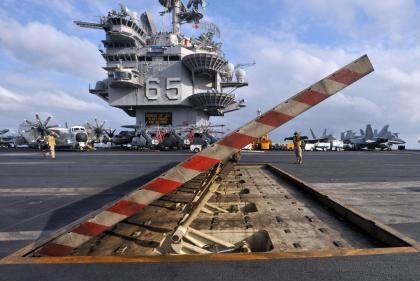
作为一艘军用舰艇,航母的抗打击能力相当的优秀,结构强度相当之高,这也给拆解带来了很大的困难,相较于普通民船的拆解更费时费力。而且拆解过程还需要注意保密问题,一些敏感的部件能搬走的搬走,搬不走的需要随船拆解的,还得派专门的工作人员负责保密工作。
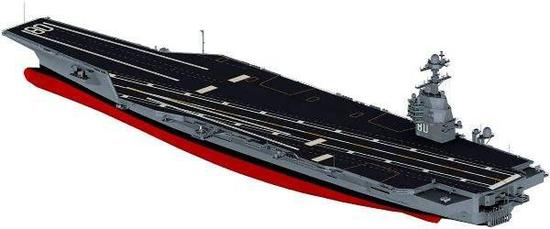 新老交替,精神长存
新老交替,精神长存
总而言之,拆解核动力航母花费巨大,因此没有相当的国力,是玩不起核动力航母的。而“企业号”这个象征着美国海军精神的名字从第二次世界大战令日军闻风丧胆的CV-6到引领美国海军步入新时代的CVN-65,将一直传承下去(福特级航母CVN-80)。(作者署名:利刃/兔子)
http://www.thedrive.com/the-war-zon...5-years-and-over-1-5b-to-scrap-uss-enterprise
 The Navy Could Need More Than 15 Years and Over $1.5B To Scrap USS Enterprise
The Navy Could Need More Than 15 Years and Over $1.5B To Scrap USS EnterpriseNo one has ever done this before and the service is struggling to figure out how best to get rid of its first nuclear-powered supercarrier.
By Joseph TrevithickAugust 2, 2018
- The War Zone
- aircraft carrier
- CVN 65
- Department of Energy
- Ford Class
- GAO
- Hampton Roads
- Hanford
- Newport News Shipbuilding
- Nimitz class
- nuclear reactors
- Nuclear Regulatory Commission
- nuclear waste
- Puget Sound Naval Shipyard
- report
- ship breaking
- shipbuilding
- Supercarrier
- US Navy
- USS Enterprise

SHARE
A new report from the Government Accountability Office, or GAO, says that it could cost the Navy more than $1.5 billion to fully dispose of the retired ex-USS Enterprise, a complete process that could take more than 15 years to finish. The watchdog says the service should get at least one independent review of those projected costs and begin keeping studious records, not only to make sure it’s getting the best deal, but to also learn as much as possible from this unprecedented ship breaking effort for when it retires its Nimitz class supercarriers.
The Navy officially decommissioned Enterprise, also known by its hull number CVN-65, in February 2017, after more than five decades of service. The ship had already effectively been in mothballs since 2012 and Newport News Shipbuilding completed a lengthy “inactivation” process, which included removing nuclear fuel, mission systems, and other items from the ship, in April 2018.
This Video About The Navy's Decaying Shipyards Makes Its 355 Ship Goal Seem LaughableBy Tyler Rogoway Posted in The War Zone
CVN-81, The Fourth Ford Class Supercarrier, Is Slated To Cost A Whopping $15BBy Tyler Rogoway Posted in The War Zone
Navy Could Extend The Life Of USS Nimitz Past 50 Years To Maintain 12 Carrier FleetBy Tyler Rogoway Posted in The War Zone
Shock Trials or No, the Navy's Newest Supercarrier Is Still an Unreliable DebacleBy Joseph Trevithick Posted in The War Zone
Emergency Declared After Tunnel Full Of Nuclear Waste Collapses At Hanford (Updated)By Tyler Rogoway Posted in The War Zone
“At approximately 76,000 tons, CVN-65 will require an unprecedented level of work to dismantle and dispose of as compared to previous ships,” GAO’s review, which the congressional office published publicly on Aug. 2, 2018, said. “Regardless of the approach the Navy chooses, CVN-65 will set precedents for the processes, costs, and oversight that may be used to dismantle and dispose of nuclear-powered aircraft carriers in the future, such as the Nimitz-class carriers which the Navy will begin to retire in the mid-2020s.”
The only ship of her class, Enterprise was also the first ever nuclear-powered aircraft carrier to enter service anywhere in the world. The Navy expects to send the USS Nimitz, the first ship in the class that came after CVN 65, into retirement in 2023, after sometime after the future Ford-class flattop USS John F. Kennedy enters service. There is already considerable debate over this plan, though, and Congress may block the retirement in order to maintain a 12-carrier fleet.

USN
Tugs move the USS Enterprise into Newport News Shipbuilding's yards in 2013.
How to dispose of the “Big E,” as she was nicknamed, has already been a complicated and arduous affair. The Navy originally projected that it would cost somewhere between $500 and $750 million to scrap it, but by 2013, this figure had grown to over $1 billion. The difficulties have forced the service to push back the start of the process more than once already and the ship’s hulk is presently sitting in Hampton Roads, Virginia.
The Navy is now considering two potential options, according to GAO. The first of these is doing the work at a naval shipyard with the help of contractors, while the second would see the service turn the ship over to a private company to break down at their own facility.

GAO
A basic breakdown of the Navy's two options for what to do with the ex-Enterprise.
Historically, the Navy has done this work at the Puget Sound Naval Shipyard and Intermediate Maintenance Facility in Bremerton, Washington. When it comes to breaking down nuclear-powered vessels, this facility has the added benefit of being relatively close to the Department of Energy’s Hanford low-level radioactive waste disposal site, which is also in Washington State. This is where the Navy would send the eight de-fueled nuclear reactors and related components from the ex-Enterprise.
GAO acknowledged in its review that the Navy had a better sense of the costs and time required to proceed with this plan based on its existing experience. Unfortunately, there are serious concerns that using one of the service’s own overworked shipyards to scrap the supercarrier would only add to an increasingly troubling maintenance backlog for active ships and submarines.

GAO
An infographic showing how the Navy typically moves decommissioned nuclear reactors from the Puget Sound Naval Shipyard to Hanford.
In September 2017, the watchdog released a separate review highlighting the poor and decaying state of the Navy’s shipyards. The next month is published yet another report specifically on delays in maintenance availabilities for Los Angeles- and Virginia-class attack submarines. At the time of writing, the Los Angeles-class boat USS Boise is still just sitting idle pier side after more than 30 months of inactivity.
The Navy only expects the repairs on Boise to begin in 2019. On Aug. 2, 2018, the service put out a request for information to try and identify commercial shipyards that it could certify for government work or ones that already have that certification, but are not working at full capacity, in order to try and make up for some of these shortfalls.
The fear is these shipyard capacity issues could also lead to greater costs if the process drags out. The Navy says the Puget Sound option could cost anywhere from $1.05 to $1.55 billion, take 10 years to complete, and wouldn’t even start until 2034.
The other option, then, is to have a contractor, such as Newport News, do the job at one of their facilities. This could shorten the time it takes to break down the former Enterprise to only five years and get the work going in 2024.
The issue here is that no government or private shipyard has ever done anything like this on this scale. It could quickly become expensive as contractors begin ripping things apart and find out that their expectations don’t line up with what they’ve discovered waiting for them – something that’s happened before with much smaller, less complicated systems, such as fighter jets.
The unique nature of Enterprise's design could make things even more complex. More than two decades after the Navy struck it from the rolls, the bulk of the hull, including the reactor compartments, of the ex-USS Long Beach, another one-off design and the first-ever nuclear-powered cruiser in the world, is still sitting in long-term storage at the Washington State base.

GAO
A graphic showing how the Navy would plan to break down the ex-Enterprise if it did the work at Puget Sound.
And though the Navy has moved reactors and other irradiated materials from Puget Sound to Hanford in the past, the sheer volume of materials associated with eight individual reactor plants will make this effort more akin to decommissioning a nuclear power plant. For a commercial contractor, getting legal and regulatory approval to dismantle the reactors, in particular, could be complicated and limit the available sites where the work could occur.
The Navy and the independent Nuclear Regulatory Commission (NRC) already disagree on what standards should apply to the commercial option. The Navy says that if a commercial company does the work, NRC’s should view it through the lens of commercial nuclear regulations. The NRC says that dismantling a naval nuclear reactor is akin to disposing of a nuclear weapon from a regulatory standpoint and that the Navy needs to be responsible for the process and disposing of the waste at a site such as Hanford.
Furthermore, NRC only has direct authority over such matters in thirteen states, not including Virginia, where the ex-Enterprise is now. State authorities have entered into agreements with the commission in all other instances to take responsibility for nuclear waste and other related matters and might not be willing to take on the task of overseeing the disposal of eight military-grade reactors. And not mentioned at all is the highly classified nature of U.S. naval nuclear reactor design, the details of which any company would have to guard very closely throughout the process regardless.
So, while there might be an understanding of the general approach a commercial company would take to break up the ex-Enterprise, there’s no real understanding of what the process might entail, especially with regards to the nuclear components. For example, GAO said in its report that the Navy, for unknown reasons, estimated that it would cost less to dispose of each of the ship’s nuclear reactors than it typically does to get rid of commercial reactors of a similar size. With so many unknowns, the estimated final cost for the commercial option is a wide range that sits anywhere from $750 million to $1.4 billion.

Steve Helber/AP
The USS Enterprise in dry dock at Newport News' yard in 2016 during the inactivation process.
“As the Navy considers how to proceed, it will be critical to ensure that there is sufficient oversight and accountability for what likely will be an effort greater than $1 billion that lasts the better part of a decade,” GAO’s reviews wrote in their conclusion. “Without establishing a cost and schedule baseline that has been validated by an independent cost estimate or assessment, it will be difficult for decision makers to track cost and schedule performance or have confidence in CVN 65 costs.”
As such, the watchdog recommended that the Navy have the Pentagon’s Office of Cost Analysis and Program Evaluation or the Naval Center for Cost Analysis draw up independent cost analyses of the two potential courses of action. They also said the service should keep and supply details accounting of the projected costs and the money it spends on the project, which it is not presently required to do for disposal programs.
In addition, GAO said that the Secretary of Defense needs to demand that the Navy craft a risk management plan no matter what course of action it takes and goes through a formal process to establish a baseline cost and schedule for the entire effort. Without this it would be difficult, if not impossible, to truly evaluate how things go, which could hamper the service’s ability to avoid the same mistakes in the future. The Department of Defense told the congressional office that it agreed with all of these suggestions.
It's also worth noting that how the disposal of Enterprise shakes out could have an impact on how the U.S. government views the costs associated with nuclear-powered aircraft carriers and could impact the growing debate about whether it makes sense to invest in smaller, conventionally-powered types. Since taxpayers will be responsible for the bill, a more accurate estimated lifecycle cost of a nuclear supercarrier should include this $1 billion or more to dispose of it at the end of the day.
As it stands now, the Navy hopes to have arrived at a final decision on what to do with the remnants of the Enterprise by 2023. We might not have to wait long to start seeing hints of which course of action the service truly prefers.
Contact the author: [email protected]
Don't forget to sign up
Your Email Address
https://www.popularmechanics.com/mi...-dismantling-uss-enterprise-nuclear-disposal/
The U.S. Navy Is Having a Hell of a Time Dismantling the USS Enterprise
Nobody has ever disposed of a nuclear-powered aircraft carrier before. Turns out it's not easy.

By Kyle Mizokami
Aug 10, 2018
5.2k

U.S. Navy photo by Mass Communication Specialist 2nd Class Cat Campbell
Six years after decommissioning USS Enterprise, the world's first nuclear-powered aircraft carrier, the U.S. Navy is still figuring out how to safely dismantle the ship. The General Accounting Office estimates the cost of taking apart the vessel and sending the reactors to a nuclear waste storage facility at up to $1.5 billion, or about one-eighth the cost of a brand-new aircraft carrier.
The USS Enterprise was commissioned in 1961 to be the centerpiece of a nuclear-powered carrier task force, Task Force One, that could sail around the world without refueling. The fleet was a symbol of the Navy’s global reach and its nuclear future. During its 51 years in operation, the Enterprise served in the Cuban Missile Crisis blockade, the Vietnam War, and the wars in Afghanistan and Iraq.
The Navy decommissioned Enterprise in 2012 (don’t worry, the third carrier of the new Gerald R. Ford class will be named Enterprise, so the name will live on) and removed the fuel from the eight Westinghouse A2W nuclear reactors in 2013. The plan was to scrap the ship and remove the reactors, transporting them by barge from Puget Sound Naval Base down the Washington Coast and up the Columbia River, then trucking them to the Department of Energy’s Hanford Site for permanent storage.
However, after decommissioning the cost of disposing of the 93,000-ton ship soared from an estimated $500-$750 million to more than a billion dollars. This caused the Navy to put a pause on disposal while it sought out cheaper options. Today the stripped-down hull of the Enterprise sits in Newport News, Virginia awaiting its fate.

USS Enteprise as part of Task Force One, 1964.
Getty Images
Now, according to a new General Accounting Office report (PDF), the Navy has two options. The first is to have the Navy manage the job but let the commercial industry do the non-nuclear work. The Navy would allow industry to scrap the non-nuclear parts of the ship but preserve a 27,000-ton propulsion space containing the reactors. The propulsion space would then be transported to Puget Sound Naval Base, where the reactors would be removed and sent to Hanford. This is the most expensive option, costing a minimum of $1.05 billion up to $1.55 billion and taking 10 years to complete, starting in 2034.
The second option: let commercial industry do everything, with a reactor storage location to be determined. This would cost $750 million to $1.4 billion and would take 5 years to complete, starting in 2024. In either event, most of the ship gets turned into razor blades and flatware. (By comparison, a squadron of 10 F-35C Joint Strike Fighters costs $1.22 billion, and a brand new Burke-class guided missile destroyer costs $1.7 billion.)
The GAO report paints the commercial option as faster and cheaper, though there are a number of unknowns. Nobody knows where the hull will be dismantled under the commercial plan, nor where the reactors would be sent. Although the Navy believes disposing of the reactors will be fairly straightforward, no one has dismantled a nuclear-powered carrier before.
Compounding the issue is a “not my problem” intergovernmental dispute. The Naval Nuclear Propulsion Program, the arm of the Navy concerned with nuclear power, says the federal Nuclear Regulatory Commission could oversee a commercial effort. But the NRC says Navy nuclear reactors are not its job. It’s not clear exactly why NNPP doesn’t want the job, although it currently has a backlog of 10 submarine reactors and two cruiser reactor to deal with (which is probably why a Navy effort won’t start until 2034). Ultimately, according to the GAO, it may take Congress to make a decision.
Whatever the Navy ends up doing, this will only be the first of many nuclear-powered carrier disposals. USS Nimitz is set to retire within the next ten years, and there are ten ships in the class. These will age out every four or five years for the next forty years, and each has two reactors. The Navy must get Enterprise’s teardown right, because the orders are going to start stacking up.
Via The Daily Press
https://tech.slashdot.org/story/18/...tle-americas-nuclear-powered-aircraft-carrier
It'll Cost $1 Billion To Dismantle America's Nuclear-Powered Aircraft Carrier (popularmechanics.com) 193
Posted by EditorDavid on Saturday August 11, 2018 @03:34PM from the owning-a-boat dept.
"Six years after decommissioning USS Enterprise, the world's first nuclear-powered aircraft carrier, the U.S. Navy is still figuring out how to safely dismantle the ship," reports Popular Mechanics. schwit1 tipped us off to their report: The General Accounting Office estimates the cost of taking apart the vessel and sending the reactors to a nuclear waste storage facility at up to $1.5 billion, or about one-eighth the cost of a brand-new aircraft carrier.
The USS Enterprise was commissioned in 1961 to be the centerpiece of a nuclear-powered carrier task force, Task Force One, that could sail around the world without refueling.... The Navy decommissioned Enterprise in 2012 and removed the fuel from the eight Westinghouse A2W nuclear reactors in 2013. The plan was to scrap the ship and remove the reactors, transporting them by barge from Puget Sound Naval Base down the Washington Coast and up the Columbia River, then trucking them to the Department of Energy's Hanford Site for permanent storage. However, after decommissioning the cost of disposing of the 93,000-ton ship soared from an estimated $500-$750 million to more than a billion dollars. This caused the Navy to put a pause on disposal while it sought out cheaper options. Today the stripped-down hull of the Enterprise sits in Newport News, Virginia awaiting its fate.
"Although the Navy believes disposing of the reactors will be fairly straightforward, no one has dismantled a nuclear-powered carrier before...
"Whatever the Navy ends up doing, this will only be the first of many nuclear-powered carrier disposals."
http://mil.news.sina.com.cn/jssd/2018-08-13/doc-ihhqtawy1356316.shtml
美军拆解一艘退役核航母 要每个中国人掏一美元才够
美军拆解一艘退役核航母 要每个中国人掏一美元才够
0
美国海军功勋航母企业号正在拆解,据美国海军给出的报告,拆解费用将高达15亿美元。而美国政府所属的问责局对此表示,高达15亿的拆解方案存在许多疑点,将会对此展开调查。
我们虽然不知道这件事里面存在什么故事,但核动力航母的拆解,并不是一件容易的事。

一般情况下,一般的船只拆解也不便宜,原因在于,船只拆解并不仅仅是将船拆了这么简单。即使是一般的民用船只,在拆解前都需要先将船体内的一切液体(燃料、润滑油、制冷液等等)抽出来,之后再将船体内的线路悉数去除,之后才能进行进一步的整体结构分解。
而到了军舰上,特别是核动力航母这样的大型主力战舰,其拆解难度将相当之高。由于特殊部件相当之多,在拆解前,需要人工将许多东西手动拆出航母,如火控系统、消防系统、弹射器等等。而且由于作战的需求,一些作战设备里往往含有一些有毒物质,需要专门的化学工作人员才能将它们移除。
更为重要的是,这是一艘核动力航空母舰,其核心部分便是核动力装备。现在的核动力航母都考虑到了进行核燃料更换,在设计之初便对核反应堆进行了模块化设计,使得更换核燃料变得方便。但作为美国第一艘核动力航母的企业号(CVN-65),其设计理念远不及现在那么成熟,想要完全将核反应堆拆除非常困难:首先得将核反应堆里的核燃料分装运出,之后还得对船体进行一定的拆解,最后才能完全将反应堆分离出船体。而且,核废料只能密封于铅罐里深埋地下,而这中间的费用令人乍舌。

作为一艘军用舰艇,航母的抗打击能力相当的优秀,结构强度相当之高,这也给拆解带来了很大的困难,相较于普通民船的拆解更费时费力。而且拆解过程还需要注意保密问题,一些敏感的部件能搬走的搬走,搬不走的需要随船拆解的,还得派专门的工作人员负责保密工作。

总而言之,拆解核动力航母花费巨大,因此没有相当的国力,是玩不起核动力航母的。而“企业号”这个象征着美国海军精神的名字从第二次世界大战令日军闻风丧胆的CV-6到引领美国海军步入新时代的CVN-65,将一直传承下去(福特级航母CVN-80)。(作者署名:利刃/兔子)


